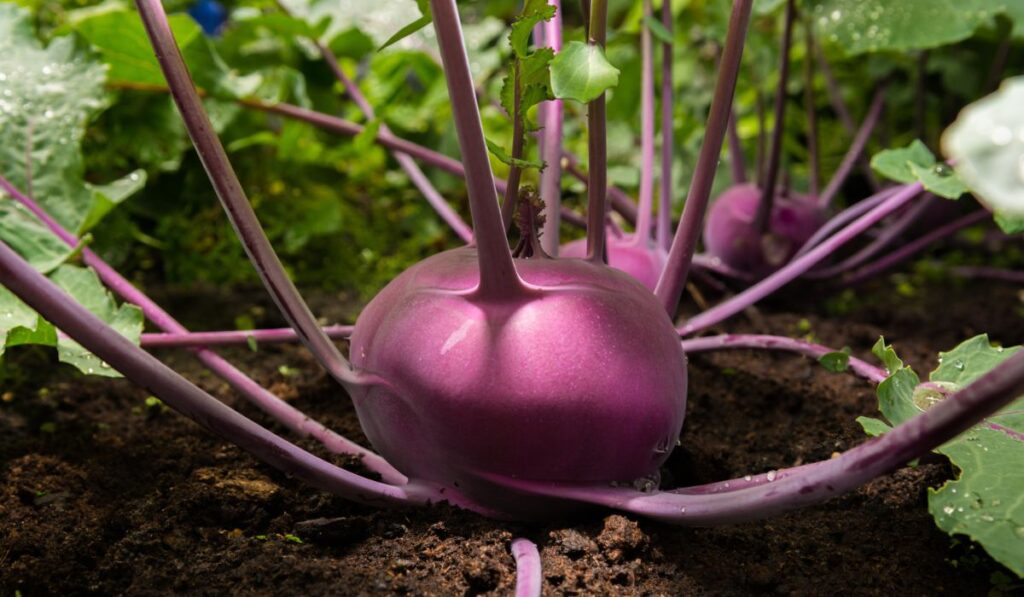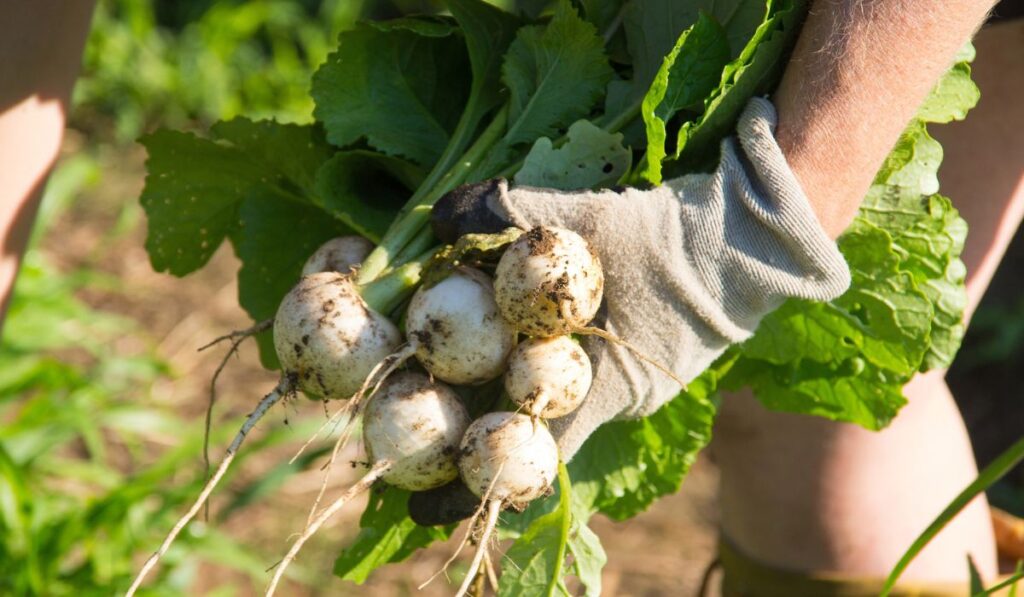Turnips are a member of the Brassicaceae family that resemble other root vegetables such as rutabagas. Turnip roots can be baked, boiled, mashed, roasted, or used in pies and soups, while the leaves taste like mustard greens and are delicious when cooked or used in salad. But when’s the best time to plant your own turnips?
Planting turnips in spring guarantees a late spring or early summer harvest. If you sow seeds in late summer, you’ll get a fall crop. Sow seeds in spring about 2 to 3 weeks before the last frost date. Turnips grow best in open, sunny locations with cool, moisture-retentive soil.
Let’s take a closer look at the best time for planting this amazing vegetable and how it should be planted. We’ll also look at the different turnip varieties as well as how this vegetable should be harvested and stored.
When to Plant Turnips

The turnip is a cool season crop that typically takes between 30 and 60 days to fully mature. The ideal temperature for turnip growth from 40 to 75 degrees Fahrenheit. Overly warm temperatures can cause woody root growth.
Turnips should be seeded into the garden directly because they don’t transplant well. Turnip seeds (on Amazon) take only a few days to germinate. Their greens can be harvested within a month, while the roots are ready for plucking within the second month.
When to plant turnips depends on when you want to harvest. Consider the following:
- If you want to harvest your crop in late spring, then plant turnip seeds almost two to three weeks before the forecasted last spring frost date.
- If you’re planning an autumn harvest, plant turnip seeds in late summer, immediately after the summer crop of beans, sweet corn, squash, or onions.
- Seeds sowed in early autumn can be harvested in late autumn.
How to Plant Turnips
Mixing a low organic fertilizer about 12 inches into the soil before planting turnip seeds helps to get a better yield. Avoid high-nitrogen fertilizers as they could damage the crop.
Sow the seeds ¼-½ inch deep, directly into the soil. Make sure that the seeds are 1 inch apart, in rows that are 12 to 18 inches apart.
Another option is to scatter turnip seeds and thin them later. Make sure that the seeds are covered with only half an inch of soil. Give a good amount of water regularly and protect your spring crops from pests with the help of row covers (on Amazon) at planting.
How Long Do Turnips Take to Grow?
Turnips grow quickly and easily from seeds and are ready to harvest in just 6 to 10 weeks. Thin out seedlings until they’re 6 inches apart once they reach a height of 4 inches.
Crowding can result in malformed, small, or woody roots. However, if you’re growing turnips for their leafy tops, then thinning isn’t necessary.
Make sure the beds are weed-free and mulch heavily to retain moisture. Be careful not to disturb the young turnip roots. Although turnips don’t require much care, consistent soil moisture is essential.
How to Avoid Bolting
Turnips are biennials but they’re treated as annuals. They flower and go to seed naturally in the second year. However, sometimes they may bolt in the first year, stunting roots and turning greens bitter, due to lack of water or nutrients or stress caused by extreme temperatures.
By identifying the cause of stress, this problem can be easily averted. The key is to provide the plants with a low-stress environment so that they can survive easily.
Taking the following steps can protect your plants from bolting:
- Make sure the soil has plenty of organic matter or rich compost before you plant the seeds. This will ensure that the turnips get plenty of nutrients.
- Too many days of very hot weather can cause the plants to bolt; that’s why proper planting time is crucial.
- The soil should be well-drained for best results.
- Pick turnips before the temperature reaches about 80 degrees Fahrenheit.
How Many Varieties of Turnips Are There?
People typically tend to overlook turnips when they’re planning their garden; however, the many benefits of this vegetable shouldn’t be overlooked.
The low-calorie root of the turnip is rich in fiber, vitamin C, and many cancer-fighting compounds that are also present in broccoli and cabbage. Turnip greens or tops can be eaten raw in salads or cooked just like you would cook kale or spinach.
Young turnip greens aren’t as bitter as mature leaves. You can grow any turnip variety if you want to grow turnips only for their greens.
The most common turnip varieties are the standard and white turnips; however, if you’re growing your turnips from seeds, you can choose from the various varieties available. These include:
- Gold Ball: This type of turnip has golden yellow skin and soft, yellow flesh. It can grow up to 5 inches in diameter. However, it’s best to harvest Gold Ball turnips (on Amazon) at 3 inches for maximum sweetness.
- Purple Top White Globe: These turnips typically mature in 50 – 55 days and are 4 to 6 inches in diameter. They have delectable leaves and a purple top with a round, white-colored root.
The spicy flavor of Purple Top turnips (on Amazon) tastes best in braises and stews. They should be stored in a cool and moist place. - Just Right: Awarded for being the best hybrid turnip variety, Just Right (on Amazon) has been able to maintain its quality even at a large size. It has pure white roots and delicious greens and can grow to 6 inches in diameter.
It’s extremely cold-tolerant and can be harvested in 60-70 days. It can be used in pickles, soups, and salads or eaten raw. This variety shouldn’t be planted as a spring crop as it tends to bolt early.
- Golden Globe: Golden Globe turnips (on Amazon) have tasty tops and roots with amber skin. It has a sweet flesh that’s firm and crisp.
- Scarlet Queen: If you want to add color to your salad while ensuring its freshness, then consider using Scarlet Queen turnips (on Amazon). these bright red turnips are flat in shape and need 40 to 45 days to mature. Their crispy and sweet flavor goes well with parsley, lemon, carrots, and honey.
Harvesting and Storing Tips

Harvesting greens when the turnips are small is best as the leaves taste best when they’re young and tender. Leaves can be cut once they’re 12 inches long.
Take care to cut the leaves at least 2 inches above the base to allow them to grow back and cut the outer leaves first. If you’re growing for roots then be sure to harvest just a few leaves at a time.
After sowing, it takes the turnips 30 to 60 days to harvest. Young turnips are more tender and can be harvested after about 5 weeks. Turnips planted in fall should be harvested after a couple of light frosts as it gives them a sweeter taste.
A light frost isn’t harmful to turnip roots or tops, but be sure to harvest your crop before the first hard freeze. Remember that freezing and thawing through the winter can damage the roots.
How to Store Turnips
Turnip roots can be stored in a cool, dark place — like a root cellar — for up to 4 months. You can also store them in a refrigerator for 2 weeks.
When storing the turnip roots in a refrigerator it’s best to use a perforated plastic bag (on Amazon) so that they don’t dry out. Also keeping them in a bag will prevent them from becoming moldy from too much moisture.
When freezing turnip roots, cut them into ½-inch cubes before blanching them for 3 minutes. Immediately put them in cold water to cool down and drain. Pack them into airtight containers, and label them before freezing.
If you live in a mild-winter region, you can leave your turnip crop in the garden and cover it with mulch for an extended harvest.
